The Power of the Private Sector
Vietnam and the United States normalized diplomatic relations, and the United States lifted its trade embargo on Vietnam, less than 20 years ago. As recently as 2006, the United States labeled Vietnam a “country of concern” and Vietnam had laws that treated foreign investments differently from those of domestic investments. It’s only been 6 years since Vietnam acceded to the World Trade Organization. Yet, despite all of that, I’m sitting here in Saigon writing this blog in a mall area that includes Polo Ralph Lauren, Kentucky Fried Chicken and Pizza Hut. American companies are major forces in Vietnam's fish food industry (and raising fish is one of the largest businesses in Vietnam), the drinks market (Coke and Pepsi are everywhere) and hi-tech manufacturing (Intel has major manufacturing operations here among others). Citibank ATMs are among the most common, and the entire Southern part of Saigon was conceived and constructed by a foreign company. So how has Vietnam come so far in attracting Foreign Direct Investment (FDI)?
I had expected to be writing an entry similar to my Singapore entries about how the government operates in attracting FDI, including hopefully some great ideas we could utilize in attracting investment to the Philadelphia area. The reality, however, is that Vietnam’s government is appropriately focused on the basics, like improving their legal system, building infrastructure and educating the citizenry. One official with whom I met told me proudly how the average income per person in Vietnam is now nearly US $1,600 (although my research indicates it’s closer to USD $2,200). I’m sure the Americans reading this blog cannot imagine living on that kind of wage, yet here it is a symbol of pride and evidence of how far they have come. So with such critical needs, one can understand how Vietnam’s governmental FDI efforts are not what I experienced in Singapore, however, Vietnam has still experienced phenomenal FDI growth.
There are absolutely some fundamental economic factors that caused Vietnam's FDI growth – the opening of Vietnam to trade and the release of pent-up demand, the fact that they started so far behind meant even small increases were large percentage increases, the fact that they have one of the world’s largest populations under the age of 40, and that it’s a very low labor cost jurisdiction. – but that would be too dismissive of the complete picture of what occurred in Vietnam. When one looks closer and talks to government officials and companies that have entered the market, a key additional factor starts to emerge -- the private sector was a driving force in Vietnam’s development.
It was a Taiwanese company that first approached Vietnam nearly 20 years ago to discuss creating a new part of the city of Saigon that utilized urban planning techniques to alleviate some of the challenges in this highly populated city with, at the time, little major business. It was this community (together with government tax breaks) that helped attract numerous companies to Vietnam. So while this one foreign investment started a movement, the movement also fed upon itselt. This developer in south Saigon talked about how they developed an area intending that foreigners would move in because of the style of housing and amenities. While that happened, she also explained that a big surprise was how one Korean company would move in to the area, and then another, and all the Koreans would want to live in the same area, and then restaurants from Korea opened in the area, and so they created a Korean school and then more Korean companies moved in etc. That may sound like a nice little story, but in fact this didn’t happen once but multiple times among many nationalities. In that same area, there is now a Korean School, a Taiwanese School, a Japanese School, an American School including also a European International Baccalaureate program. I also heard from multiple individuals that because of the good experience of X company, they decided to try the market. Ultimately, however, no company with whom I spoke credited the government or any particular program. Each independently chose Vietnam for other reasons, but also in each case, the fact that other companies reported positive experiences was a key reason to choose Vietnam. Moreover, this experience cut both ways. One person I met pointed out that you do not see many Indian companies in Vietnam. He explained that this was because allegedly Tata had a very bad experience in Vietnam, and therefore other Indian companies were loathe to enter the market. Thus, the power of reputation and experience, not government assistance, seems to have proven a powerful driver in the case of Vietnam.
The private sector also seems to have been (and continues to be the) driving force behind reforms to Vietnam’s legal system that many individuals pointed out have been key to increasing foreign direct investment. These would include things like the need to crack down on corruption, improve intellectual property protection etc. One former government official in charge of attracting FDI pointed out how Vietnam says the right things and seems to be succeeding at attracting FDI, but that the central government actually has no clear policy to attract FDI. In his words, “[i]f it’s so important, show us the policy and efforts that sit behind trying to attract FDI – there are none.” So he, and others in the private sector, continue to push for the types of reforms that at the end of the day result in a promoting FDI, even if not the result of a specific policy. One company representative I met even criticized the few trade promotion materials the government does have – saying they were too wordy and not helpful. At the end of the day, he felt the government spends too much time building buildings and not enough time building roads or doing things that would help attract foreign investment. He also makes this point to the governement, and again, is another attempt by the private sector to influence the government to act in ways that promote FDI.
So how is FDI promotion happening in Vietnam? It is happening somewhat by the Federal government, but perhaps even more so at the provincial level with provinces engaging in their own activities and even independent trade missions to try and attract investment. The most concrete examples I received, however, were from the private sector. I met a large investment fund that regularly goes to the U.S. to find investors willing to invest in Vietnam. I met with major global companies that tout the benefits of being in Vietnam both as a site for production but also as a major market in which to sell goods. I met multiple lawyers, and in fact was concerned I was meeting too many. In fact, I learned that lawyers in Vietnam are often the first stop for foreign companies considering entering the country. They are an integral part in helping these companies enter the market, but also in pushing for changes in the law to promote FDI. They are also adept at helping foreign companies obtain licenses without having to make corrupt payments. It is these lawyers who pushed for WTO accession and now hopefully participation in the Trans-Pacific Partnership. It is also these lawyers who have been pushing for enforcement of Vietnam’s international treaty obligations and seeking higher standards for intellectual property protection. In addition to businesses and the legal profession, there are also quasi governmental non-profit organizations like the Vietnam Chamber of Commerce and the Vietnamese Business Forum that push for change. Perhaps the most illustrative example of the changes occurring in government due to the force of the private sector is that the National Assembly now includes members of the business community who are not members of the Communist Party and yet who were elected over their Communist Party competition. Ten years ago this would have been unthinkable. So as I reflect on my time in Vietnam, I am not disappointed in what the government has done to attract FDI, but am instead impressed with what the private sector has accomplished. The power of the private sector is alive and well in the Socialist Republic of Vietnam, and if it can thrive and impact society here, imagine what it can do in a democratic republic.
Next stop, Brazil in July...
Singapore and FDI – attitude makes all the difference.
While in Singapore I have met with executives from Blackstone, Cigna, Fortis, GSK, ISOS, MasterCard, MHCAsia and others. Uniformly, these executives talked about the approach of the Singaporean government – the attitude – as being a critical part of the reason they chose to locate in Singapore. This “attitude” is pervasive, but seems to have particularly reflected itself at three different times during the market-entry process – the approach, the market entry and the follow-up.
On the approach, it was very interesting to learn that the government of Singapore often does not make the first approach to a potential multinational company. Instead, they go to a major multinational company in a related field already in Singapore, and ask that that lead executive contact their peer and ask them to consider locating in Singapore as well. This is not to say that the government doesn’t also make the approach. They do in many cases as well. For example, the government will target specific “big names” that they believe they need to have in Singapore for prestige or to round out an industry etc. and make the approach themselves or in addition to another local CEO. This too is where “attitude” matters. From many sources I was told that Singaporean government employees are highly paid compared to those in other countries. Often these salaries, particularly among senior management, are competitive with the private sector. As a result, the government can attract the best and the brightest, and often those who have been educated in an international setting. Thus, these senior executives are also uniquely positioned to have the conversations with the senior executives of the target company. One foreigner whose company was considering moving from Korea to Singapore was taken aback by the quality and specificity of the technical questions his people were asked, and in some cases they had to go back and ask some of their R&D team to answer the questions because the questions from the government were so technical that they were “over the heads” of those at the meeting from the company. He felt like the government understood what his business might need down the road in Singapore better than he did when it came to the technical aspects.
The “attitude” also presents itself in assisting companies when they actually enter the market. As one executive described it, “Most countries think you’re trying to enter their country to exploit them. In Singapore they want you to come for their mutual benefit, and so approach the entire relationship as a partnership. It’s a different mind-set.” Another executive described this attitude as looking at each potential MNC as a customer. Customer-centricity is a buzz word in many multinational businesses today to describe the need to focus on the customer, and that is how the government of Singapore was described -- customer centric. The government’s assistance was described by more than one executive as “they made it easy”. According to one executive, the government took care of everything and he never had to fill out one paper. He said “Where else can you enter a market and not be required to complete reams of paperwork?!” In Singapore, the government met with his team and helped get whatever was needed to be put in place so he never had to actually complete any of the papers himself. I also heard from multiple companies that the government helped them integrate by introducing the executives around within the government to various ministers or other officials with whom they would be working. These executives are also occasionally offered the opportunity to sit on government boards to meet other company executives and government officials. For example, the government recently organized an Economic Strategies Committee to look at planning in a variety of areas for Singapore, including how to make Singapore a “global city”. These committees included equal representation from the private and public sector, but also included a diverse array of individuals from a variety of industries as well as the arts and academia. This attitude of wanting to link companies who enter the market with other leaders in both government and the private sector is a unique attitude that all of the private sector companies lauded.
Lastly, Singapore’s attitude in treating these companies as being in a long term relationship was one that resonated with all of the businesses as well. Each company talked about the regular follow-up they would have with the government. Some of these discussions were to ask questions to see if there were ways the government could help – did the company have what it needed to grow, were visas taking too long, are they finding the right local suppliers etc. Some of these discussions were more general and were around different things going on in the industry, or were just an opportunity for the government to learn more so that it could respond appropriately. This constant learning is also an added for the government because their attitude has been, and continues to be, one of always wanting to be at the forefront, and of remaining agile so as to pivot when necessary to maintain their leadership as a premier location for international business. One executive summed it up best when he said that “the government treated us like a customer and made us feel good about the process”. If attitudes are contagious, it sounds like this is one worth catching. Tomorrow, Vietnam…
My first impression of Hanoi was that it was a charming city with its the French Asian fusion architecture, cafes and tree lined streets. Yet, it's also very confusing. Traffic laws don't seem to matter, cars and motorbikes come within inches of each other regularly and the sound of the city is a cacophony of car horns. Hanoi is also confidential and secretive. There are private courtyards, high walls and hushed conversations. Why does this matter? Because while these attributes describe the city, they also describe my experience investigating FDI here.
I have met with many government officials, business leaders and company advisors. They were all very kind to spend time with me before the Vietnamese holiday and shared a lot with me about their jobs. They were very nice, charming even, but I found many of the conversations confusing. One conversation began not with a discussion about Vietnam, but a long speech about why Singapore's success was not sustainable. Another told me I really needed to spend a lot more time studying the last twenty-five years of Vietnam's economic history to be able to understand FDI in Vietnam. Still another spent over thirty minutes of our hour together trying to get the most specific details about who funded the Eisenhower Fellowships. I later found out from a long term foreign resident of Vietnam that this individual was actually in the secret police. Almost every meeting had a person in attendance, typically not introduced, whose sole job seemed to be to take copious notes. In one meeting, anytime I asked a "tougher" question, like about what hasn't worked in Vietnam, the note taker would grin widely while the person answered. Most important, unfortunately most of those with whom I met asked that I not attribute any comments to them. So my discussions were also confidential. Thus, my blog entry today is unusually brief, but i'll conclude by including a photograph of a charming building in Hanoi. It may be confusing as to whether it's a private residence or government office, but I won't tell -- it's confidential.

Ships waiting to come into port
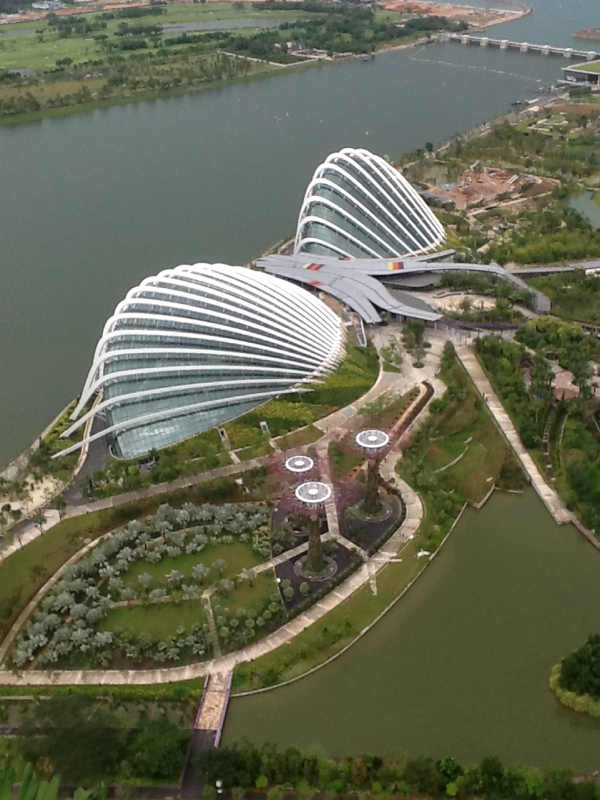
The new Gardens by the Bay in Singapore
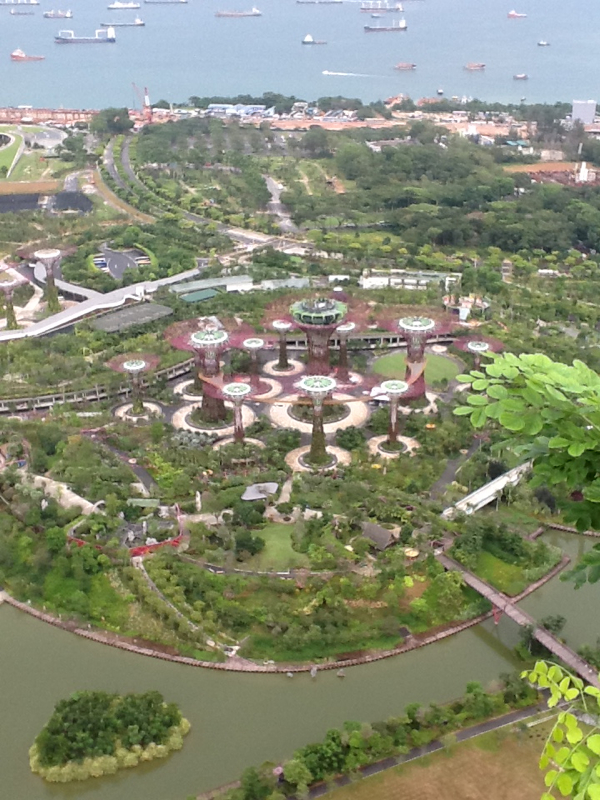
More of the Gardens
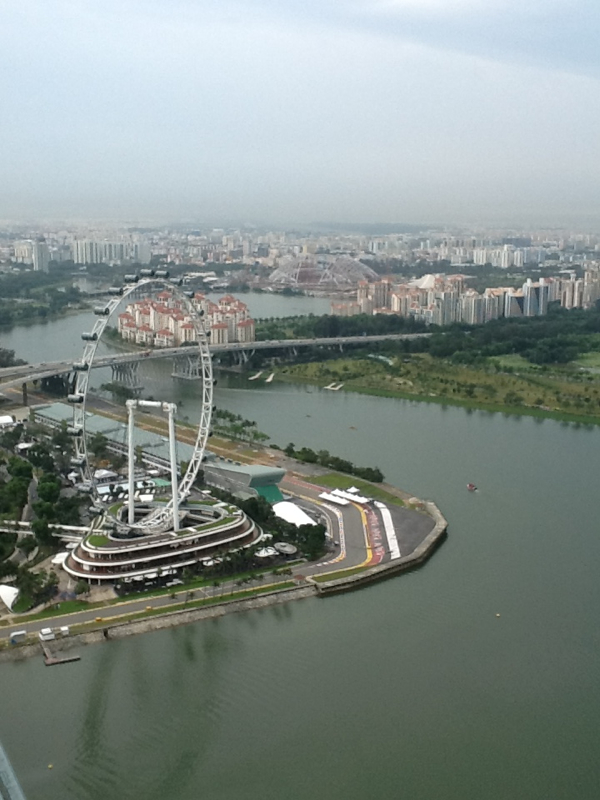
The Singapore Flyer
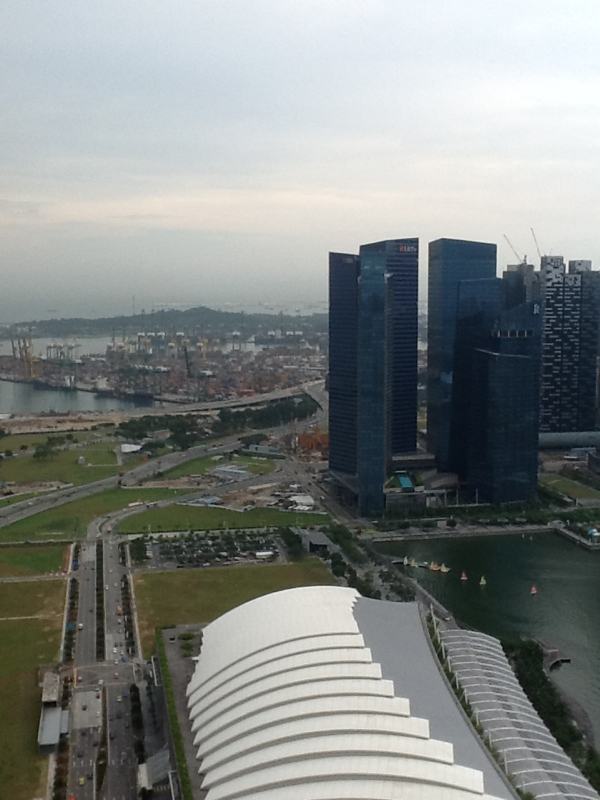
The port
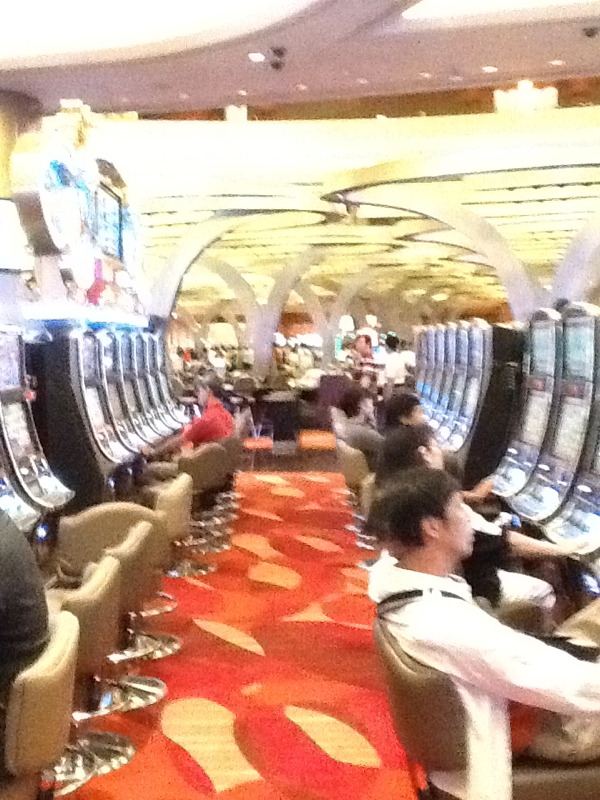
Inside the Sands casino (from the roof of which I took many of these photos)

Inside the Flower Dome

The Cloud Conservatory 35 meter indoor waterfall
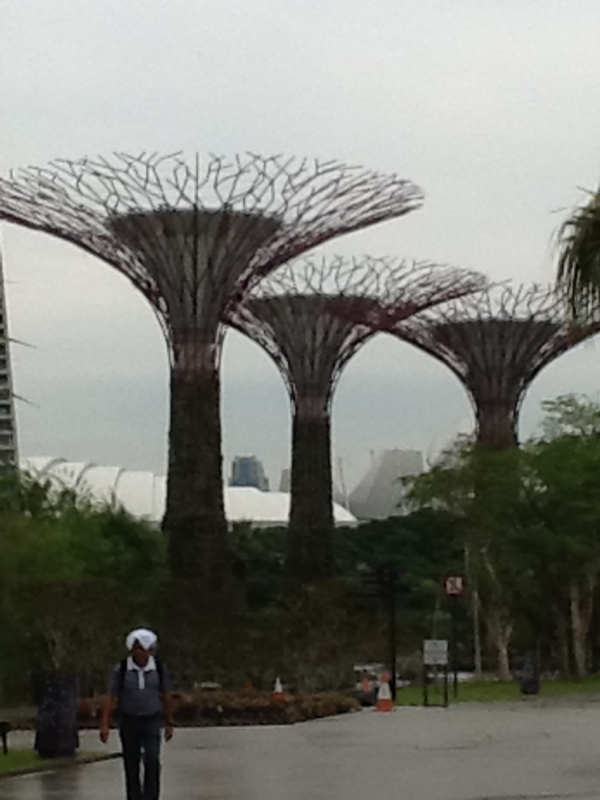
Supertrees, metal construction with plants growing up and down them

Louis Vuitton, Cartier, Yves St Laurent, Harry Winston, Christian Dior, just your average mall ...
"Who needs freedom when we have a good life?"
The above quote was relayed to me by an American who has lived in Singapore for decades. He heard something on the news he didn't like and made a comment about the government limiting certain freedoms and this was his Singaporean wife's reply: "Who needs freedom when we have a good life?" This sentiment captures another part of the secret of Singapore's success - tight government control.
In Singapore there is virtually no drug problem. Why? If you're caught with drugs you're put to death. The streets are incredibly clean. Why? Litter or chew gum and you could receive a very large fine or even a Corrective Work Order (i.e. a requirement to perform hard labor). There is little crime. Why? Rob someone and you may be caned (the same potential punishment for foreigners who overstay their visa). Traffic? Not really a problem because the government limits the number of cars on the road. And those cars are sparkling clean. Why? Because the government requires it. All the expats I have met in Singapore talk about these restrictions as somewhat oppressive, but they also all say that one gets used to them over time. The locals don't seem to see it as anything other than logical government policy.
My meetings today consisted of a health and wellness startup company, the Monetary Authority of Singapore (MAS) and GlaxoSmithKline. The startup is being assisted by Spring (the government agency that assists small to medium sized businesses). The company is doing amazing things in the world of healthcare and wellness. Living in that world myself, and working for an industry leader in healthcare and wellness, I can attest that they are at the forefront of combining technology and wellness. They are a "startup" yet already have an enviable list of customers and have expanded into Malaysia and Hong Kong. That said, the lawyer in me couldn't get past the privacy issues around their use of data. It turns out that the government barely restricts the use of data by them, and in fact they have been lauded by the government and in the press for collecting one of the most impressive databases of personal health information that hopefully can be used to benefit Singapore in the future. They can even give data to employers so they can "talk" to employees who see the doctor "too much". While Orwellian and frightening to an American, the Singaporean seems to view the good of the country as more important than that of the individual.
Yesterday one Singaporean was telling me that his son is a successful consultant in Atlanta but wants to move back home to Singapore. The challenge is that he and his wife would have to give up his 4000 square foot home for a 1200 foot one, and his large Infinity for a small Honda. Is he willing to do that? I then learned today that not only will his house be smaller, but he may not be even be able to determine where he lives. Singapore is said to be nearly 1/3 expats, but beyond that the native Singaporeans are ethnically, Chinese, Indian, Malay and even Middle Eastern. Yet, they don't have the racial tension we have even in Philadelphia. This is no coincidence. I'm told that the government works very hard to insure they maintain racial harmony, such as by requiring the various ethnic groups to live among one another by limiting the number of any one group that can live in an area. This is something we couldn't begin to fathom in the U.S., and yet it does create the desired results of racial harmony in Singapore.
While some of these actions seem like overreaching government interference to Americans, one must admit that they do further encourage the economic climate that drives Foreign Direct Investment. When Switzerland was having its banks opened up under international pressure due to its historic secrecy laws that made it a tax haven, international bankers in places like Singapore were salivating. The influx of capital they anticipated that would enter their banks upon leaving Swiss banks was immense. When MAS realized this, they met with and sent a letter to all major banks in Singapore warning them that they were not to take this money, and if MAS saw large increases to a bank's capital, they would investigate. MAS realized that while the short term gains from this situation would have been immense, and even the longer term benefits of replacing Switzerland as the world's banking center was attractive, allowing this to occur would have been shortsighted because (a) it would negatively impact their value proposition of being a compliant and transparent place to do business, and (b) over time the countries of the world would simply shift their focus from criticizing Switzerland to criticizing Singapore - a risk this small island country couldn't take.
So I am learning a lot from Singapore, and there is a lot we in Philadelphia could do better, but there is a lot I've learned that clearly provides certain advantages to Singapore that we would never (and should never) consider. For example, it took me two hours to get a cab home from my last meeting tonight because there is a limit on the number of cars allowed on the road and it was rush hour on a Friday night. So there is a clear downside to this government control. More importantly, this control affects one's personal freedoms. As the U.S. Supreme Court considers the issue of gay marriage this month, the Singaporean Supreme Court upheld the criminalization of even being gay this week. So who needs freedom when we have a good life? We Americans do.
“If you plan for one year, plant rice. If you plan for ten years, plant trees. If you plan for 100 years, educate mankind.”
-- Chinese proverb
If I have learned anything from the last 24 hours of my Fellowship, it’s that Singapore’s incredible success story is no accident. To those who say that the hurdles are too large for a city like Philadelphia to become the leading center of multinational business in the United States, I would suggest they look at Singapore. Upon gaining independence from Malaysia in 1963, Singapore was a small island with no resources, a largely uneducated population and a GDP of approximately USD $512 per person. 45 years later and that GDP was US$36,537 and Singapore was an economic powerhouse and a hub for multinational businesses’ Asia operations. To put that into context, during that same period, Malaysia’s GDP per capita expanded at one-third the pace, raising GDP per capita from US$335 in 1965 to US$6,975 in 2009. So how did Singapore do it? There are many answers to that question, but many of the answers start with one premise – planning.
The last 24 hours have been a whirlwind – meeting with members of Singapore’s Economic Development Board (the “EDB”, the statutory body tasked with encouraging foreign direct investment in Singapore), SPRING Singapore (the agency tasked with developing small to medium sized businesses in Singapore – whether foreign or domestic), JTC Corporation (the agency that is tasked with planning and developing the industrial landscape in support of Singapore's economic advancement) and the Agency for Science, Technology and Research (A*Star). I also met with senior executives of two companies (International SOS – a multinational company founded in Singapore by a group of Frenchmen, and Fortis – a multinational healthcare services company founded in India but with a major presence in Singapore) and met with Wong Meng Meng, founder of the largest law firm in Singapore and until recently President of the Law Society of Singapore. I was also taken to lunch by a group of past Eisenhower Fellowship winners from Singapore. One thing is clear from all of these meetings; Singapore planned its development and continues to do so today – for the short term, medium term and long term. How many communities have a 20 year plan? More important, there is a well coordinated machine of efforts in all parts of the government with the common task of developing Singapore as a leading economic center in the world.
In business today, there is a popular concept called a BHAG – a Big Hairy Audacious Goal. These are goals that seem nearly impossible but that companies set as a “stretch goal”. Well Singapore deserves credit for not only creating what may have been the world’s first BHAG, but also achieving it. More than one interviewer credited Singapore’s planned coordination and execution of its difficult plan as being borne from the desperation of a small country. But when one probes this concept, what that really meant is that because the stakes were so high, the country had to focus intensely on meeting its plan by paying attention to trends, and planning accordingly.
One factor that helps Singapore achieve these ambitious goals is the coordination and single-minded focus of all government agencies. Unlike what one sees in the United States or most parts of the world, in Singapore the government agencies are extremely linked. For example, they meet together regularly so that the EDB can talk about the types of multinational companies looking at Singapore and those they want to attract, so that the JTC can develop the industrial park to support that industry, so that Spring can make outreach to these companies (and in particular to their small and medium sized suppliers) to help them develop, and so that A*STAR can focus on research and development in fields that matter to these industries, all in a concerted effort to create the right environment for an industry to thrive. As one interviewer put it – “[t]his isn’t really investment promotion; it’s industry investment.”
What was also fascinating was the clarity of the brand that is “Singapore” among all the various individuals I met. This isn’t a brand that the country wanted to create mentally by advertizing in print media. It’s a vision they created for Singapore, and then achieved, that resulted in a brand. In other words, they created it through…planning. In brief, that brand is:
Trust – Singapore is a reliable place to do business, with little or no corruption
Knowledge – they have a strong knowledge base and highly educated workforce (both native and expatriate)
Connectedness – they are a physical hub for the Asia Pacific region and have a strong history of trade and transportation
Life – living and working in Singapore provides a good life – it’s safe and clean, there is good shopping, fine restaurants and culture (which more so than in the West, is fairly uncommon in Asia)
The government makes a concerted effort to maintain each of the above in their plans – whether it’s by keeping Singapore Airlines and their airport as high quality as possible to promote their “hub” status, or by making huge investments in education and R&D, or by heavy enforcement and consistency in the law promoting intellectual property rights and criminalizing corruption.
All the planning in the world, however, won’t be effective without coordinated support for the plan and individuals working tirelessly to bring that plan to fruition. In Singapore, the agencies tasked with the various aspects described above not only meet regularly and coordinate activities, they cross-fertilize. As an example, the former Chair of the EDB used to work for A*STAR and vice versa. The CEO of JTC used to work at the EDB. They not only meet to coordinate, but their respective leaders are all colleagues and even past employees of each other’s agencies. They also avoid becoming too insular by inviting private companies to sit down and tell them what they need or how the government can better help on a regular basis. They do this in group settings that are industry-based, as well as in one-on-one meetings. I will admit that I was surprised to get an e-mail from members of the EDB who heard I was coming to Singapore and so thought it would be a good opportunity to discuss my company’s progress in Singapore since we entered the market a few years ago and to see how they can help. The lawyer in me was immediately suspicious (since it’s rarely a good thing to have a local government request a meeting) but in this case it was exactly as represented. The meeting was a pleasure and they really wanted to see how they could help. As described by one private sector interviewee:
“You can have an open dialogue with the government here, and it’s not confrontational or suspicious. Where else can you sent up a meeting with the tax authorities in which they will sit down with you and walk through your taxes with you and explain how to calculate them.”
That kind of trust can only be built with experience, but the government also puts its money where its mouth is. For example, A*STAR is currently in its 5th 5 year plan. This is a S$ 16.1 billion (or about USD $13 billion) plan focused on attracting R&D talent to Singapore, building research institutes and creating technology that benefits the industries in fulfillment of the overall plan for Singapore’s development. This includes launching a new industry project every 1.5 hours, creating 10-12 new companies a year and spinning off about 1 new company a month.
So as I reflect on what I have learned in the context of the greater Philadelphia region, I wonder if we have a 20 year, a 5 year or even a 1 year plan that is shared cross government agencies and that focuses on the economic development of our region through coordinated attraction and development of foreign direct investment. So I’ll end this entry the way I began, with a Chinese proverb:
“If you don’t know where you’re going, any road will get you there.”
This afternoon I first met with Professor Neo Boon Siong, Chairman of the Nanyang Execution Programs and former Dean of the Nanyang Business School, Nanyang Technological University (NTU), Singapore. He is also a Fellow of the Civil Service College and the Centre for Liveable Cities, and was the founding Director of the Information Management Research Centre in NTU and the Asia Competitiveness Institute in NUS. He currently serves as Director on the Boards of OCBC Bank, k1 Ventures Ltd, and J Lauritzen Singapore. After meeting with the Professor I met with senior members of Singapore's Economic Development Board, including the Assistant Director. A key theme from the day is that Singapore does not approach FDI as a tax issue or even a jobs issue, but rather as a long term strategy. Prof Boon Siong described Singapore's FDI focus as finding a value proposition and sticking to it. To that end, they don't compete for certain companies, nor do they look at "win/loss" in terms of attracting certain companies. They respond to market changes (and establish close relationships with industry so they know what's coming and where industries in general are going). Yet, this only applies when they have chosen to focus on the sector (which focus is beyond a "nice to have" but rather based on companies desiring to come to Singapore, as well as what works for Singapore). They work with such companies, even going so far as to create dedicated office parks, seeking input around what is good from a physical and regulatory environment, and encouraging the SMEs that supply these industries to also locate nearby. A key to this is being disciplined and focusing on long term and not quick wins that would be inconsistent with their plan, going so far as to not work with certain companies interested in Singapore if they don't "fit" the plan. Singapore had advantages in creating a cohesive message to attract FDI around industries including one statutory body (governmental but largely independent) and no multiple layers of federal, state and local efforts at FDI. That said, it was impressive to learn about the role the EDB plays in getting the various government agencies in a room to work together to gain alignment and help promote the industry they're trying to attract. They also do this with companies in the industry they're trying to develop, getting feedback to bring to the interagency meetings, even going so far as to bring in universities to shape curricula around what's needed by the industry. Another interesting part of Singapore's process was the creation of a Singapore brand or value proposition. For Singapore it's TKCL - Trust (it's a highly ethical environment), Knowledge (they have a highly educated workforce with strong institutions of higher learning), Connectedness (they have strong connections via trade, transportation and immigration with the rest of the world, particularly Asia) and Life (a great lifestyle in Singapore in terms of development, restaurants, arts and culture etc.). Overall, Singapore exhibits a great deal of discipline around creating a plan, sticking to it even at occasional short term losses, and globally consistent messaging. When asked how this was all created, the consistent response was that as a small country they had no choice. To paraphrase one person "the psyche of a small country requires attention to trends and advance planning". If that's the case, perhaps the Philadelphia region should start acting like a small country.
For my first meeting, I was honored to meet with a former Eisenhower Fellow who is the Prime Minister's Deputy Secretary (Development) Public Service Division. We met over a delicious Singapore lunch (satay and a fried carrot and shrimp dish for me) and discussed economic development and foreign investment attraction in Singapore. Perhaps the biggest takeaway for me was the discipline applied in Singapore. They don't approach FDI as a "take what we can get" nor do they simply say "what do we want". Singapore looks at who is interested in Singapore, and then, for example, if a few clean tech companies approach them, they work with these companies to bring them in but focus far beyond these companies and look at what would benefit that industry overall such as by encouraging these entities to set up in the same area so they create a hub area for that industry and encouraging the SME suppliers to also set up in Singapor. They offer incentives but try and stay away from tax incentives believing it to be a "race to the bottom". Another great example was casino development. singapore, after many years of banning casinod, decided to offer two licenses in two locations they chose.. There was no cost for either license per se, and instead the bid process consisted of what the winners would do for the community. As a result, the winners were not those willing to pay the largest one time fee, but those willing to build architecturally significant buildings, that included high end hotels and high end shopping with the promise of economic development, tourism, city beautification and more. A lesson from which we in Pennsylvania can learn.
|
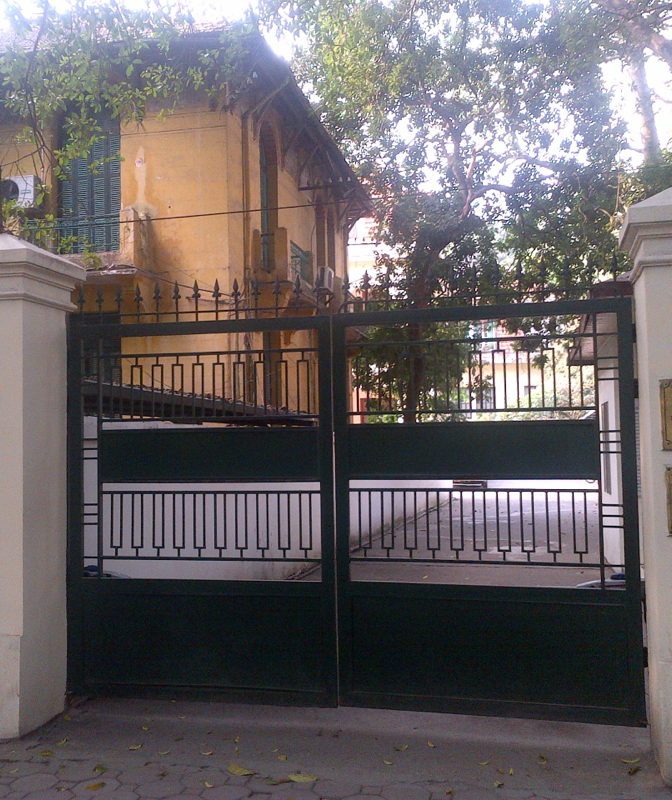










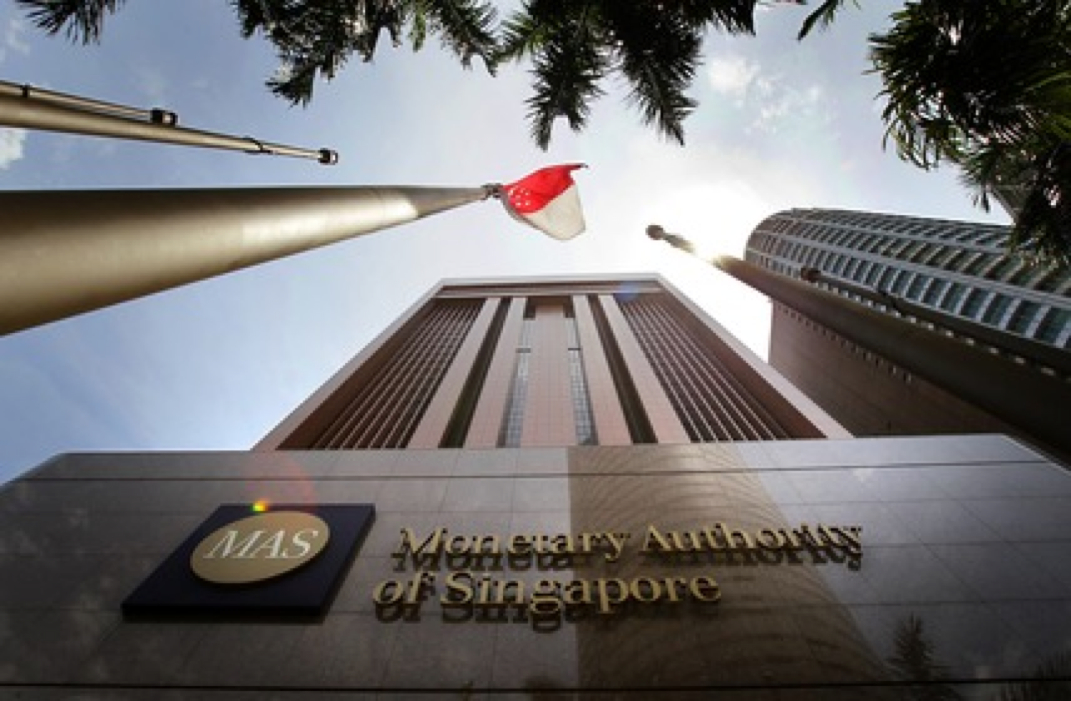
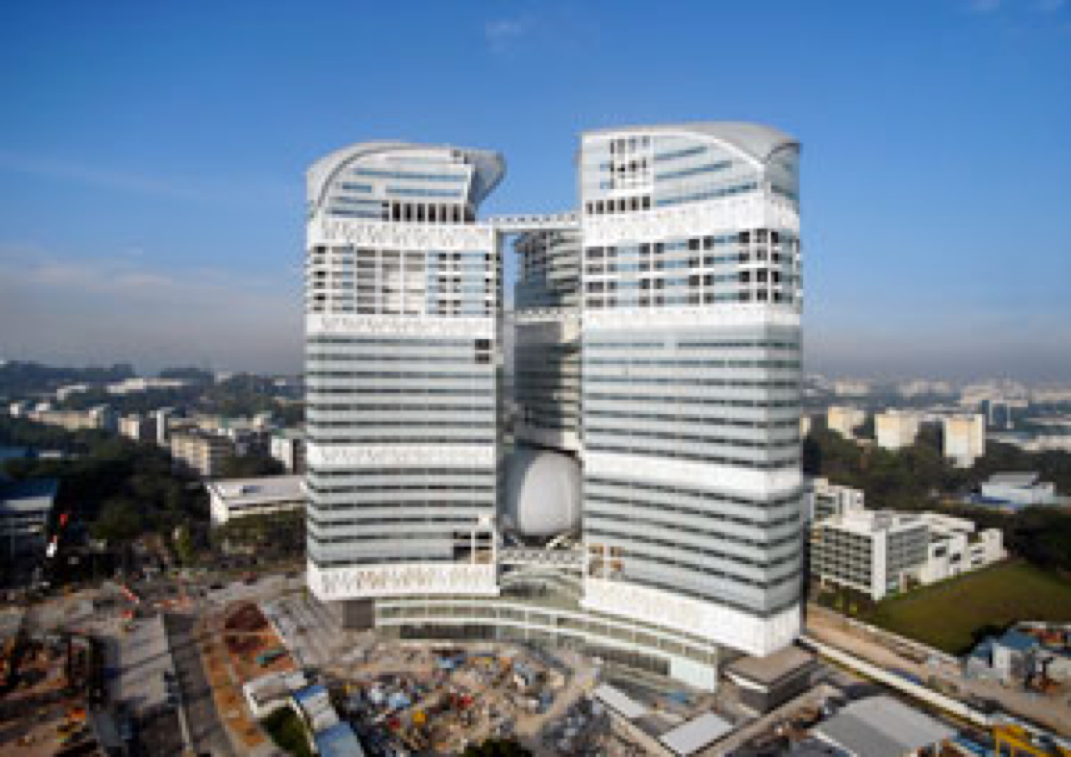
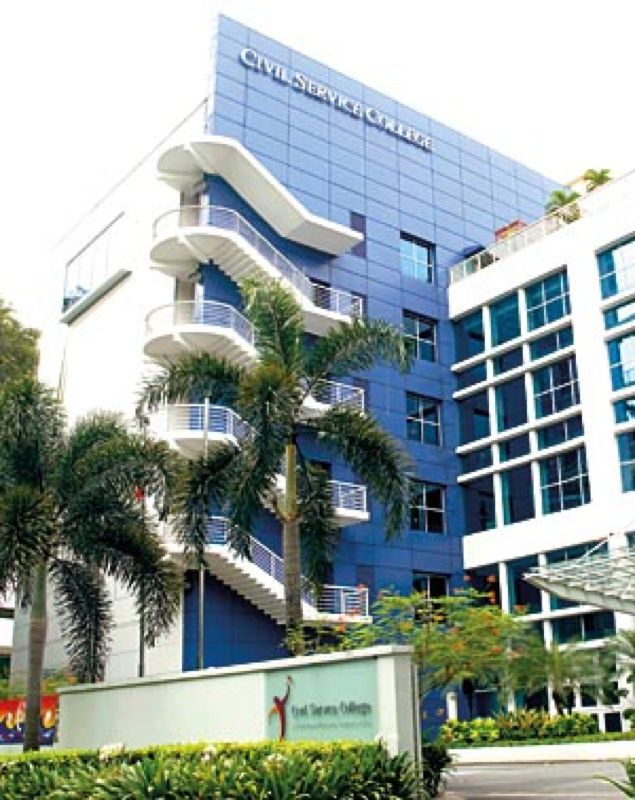
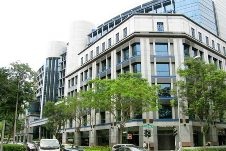
 RSS Feed
RSS Feed